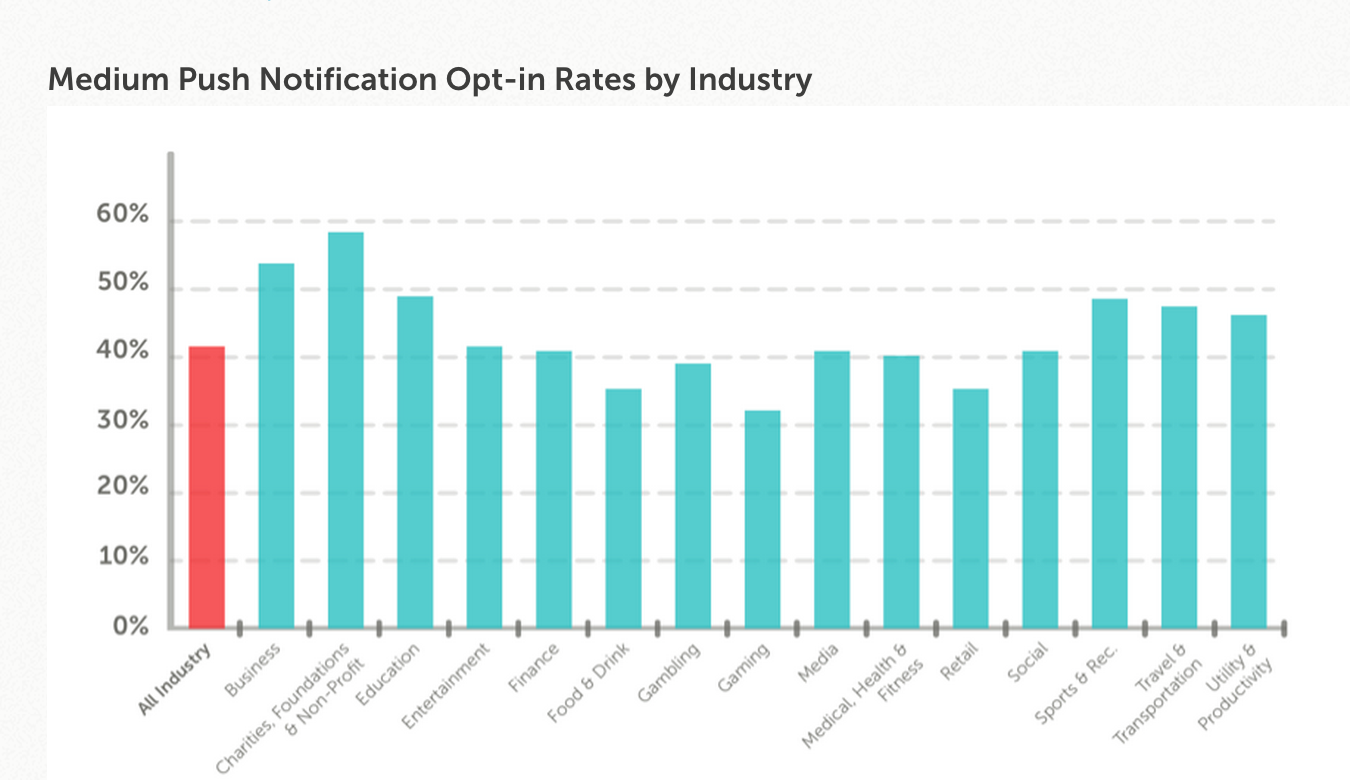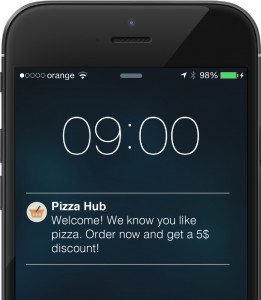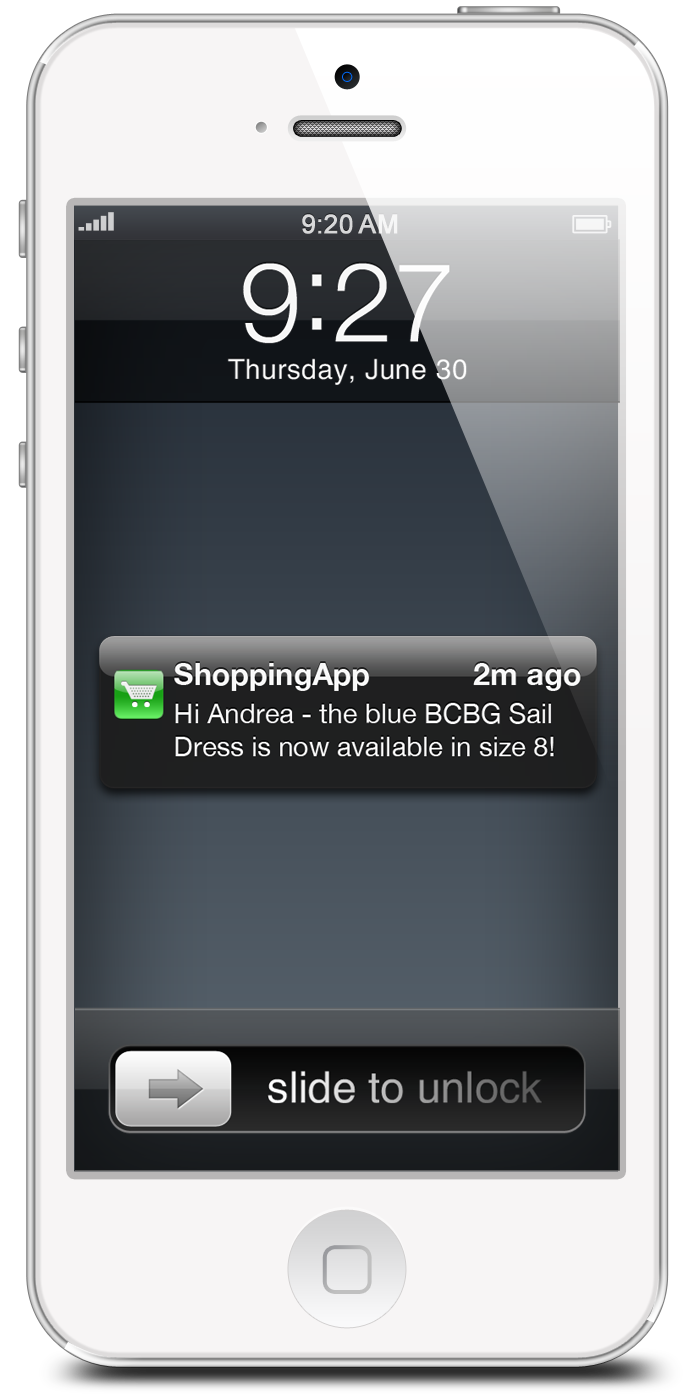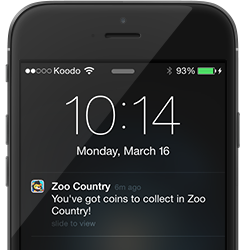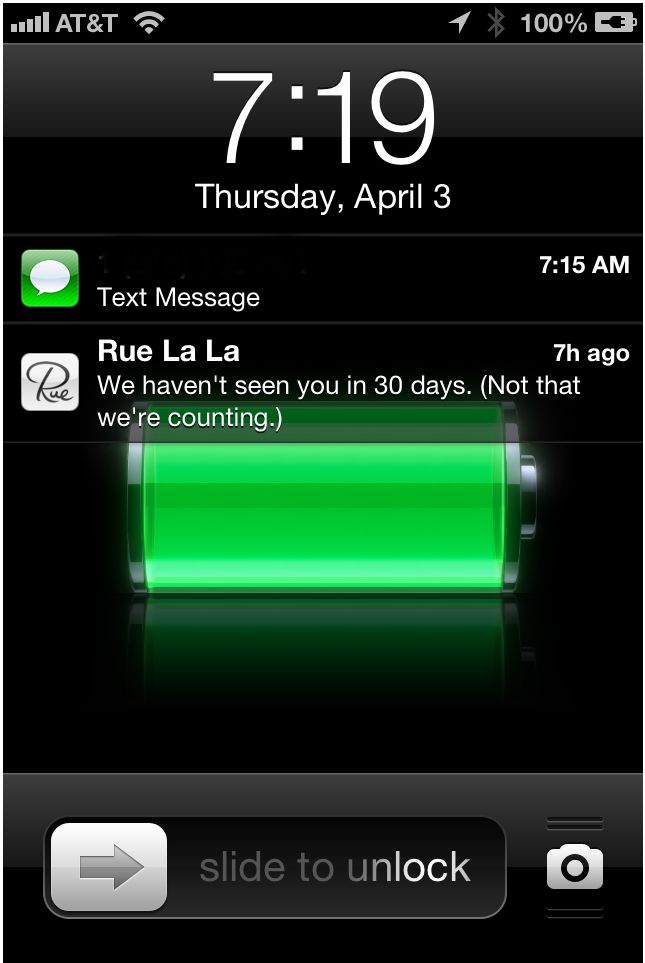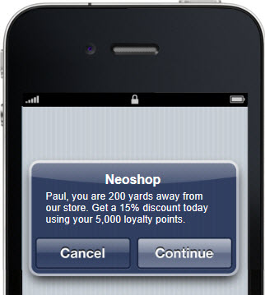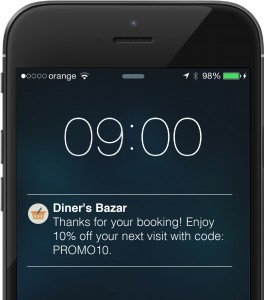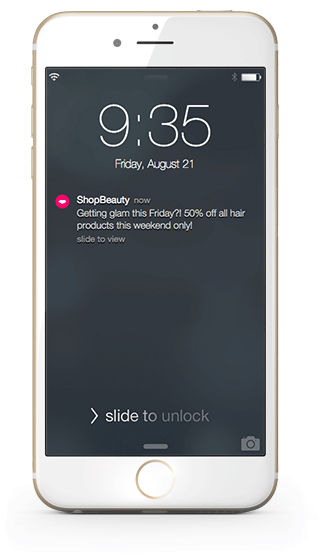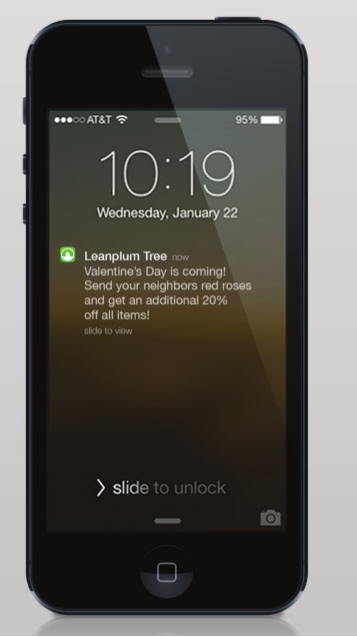6 Proven Ways To Make Your Push Notifications Irresistible To Open
Push notifications are a powerful engagement strategy for app developers, hyped particularly because of their personalisation and targeting features.
When used appropriately, they can bring your brand closer to users, make them more loyal and increase their frequency of app use.
Unfortunately, given the now widespread adoption (and abuse) of push notifications by some marketers, opt-in rates are at an all time low.
This data from Urban Airship show that across all industries, the average opt-in rate is 43%, although high-performing apps see notification opt-in rates above 50%.
New data also shows that 60% of users opt-out of push notifications.
To give you the best chance of being one of those rare high-performing apps, in this post I want to show you the top 6 strategies for how to use push notifications.
I’ll also explore some best practices for pushing notifications at the right time, to the right audience, with the right content and copy.
Bonus: 11 Most Popular Push Notification Services
Before we start…
There are 2 types of push notifications that will increase user engagement.
- Advanced Push Notifications
User Engagement Platforms like Appoxee let you custom tailor and schedule automated push notifications to engage users.
The idea is to get users to take certain actions, be it open the app, make an in-app-purchase, share to Facebook or rate the app on the App Store.
Here’s my favourite part about push notification strategy – we can see:
A) What demographic returned the best response to our messages;
B) At what time we got the highest response rate, and;
C) How many responses came from each location, etc.
Marketers love this stuff because they can measure and target their efforts to optimise for a higher user engagement rate.
2. Behaviour-based notifications
In addition to time-based pushing notifications we can also push messages to people based on their behaviour, actions they take or actions the have taken.
For example, Joe opens the app for the 5th time which indicates to us that he’s enjoying the app.
Well, if he’s enjoying the app then maybe he’d like to rate it? So we send him a notification to rate the app on the App Store/Google Play.
Or if Joe has already rated the app then perhaps we could encourage him to share it on Facebook as well.
Can you see how easy it is to get creative with user engagement strategy?
Alright, now let’s start on those best practices!
The top 6 ways to use push notifications
1. The welcome message
Get friendly with your users! This is where you make your first impression, and it needs to be a strong one.
If a new user doesn’t return to your app within the first week, there’s a 60% probability that he or she will never come back.
The goal of the welcome message is to set up the relationship with the user, and get the user to launch your app again.
Decide what tone you will use in your messages, and stick to it. There’s no going back after this first message!
The other thing you need to communicate in this message is an immediate value offer.
This is why many apps will offer a small discount or run a referral program in their welcome message.
It makes the user more enticed to open your app, and it also provides a call to action for what you want them to do on their second visit.
2. The ‘gentle nudge’ message
Many users will exit your app before finishing an action.
This might be a game, a purchase that they never checked out, a photo or message they never finished sharing on social media…whatever your app, there is usually an action that people can leave in the middle of!
The goal of the ‘gentle nudge’ push is to remind users to complete their last action.
This type of message is an essential one for every app marketer to have in their toolbelt, because it pushes your users down the conversion funnel.
If you segment your users based on their past in-app behaviour and intent, you can push highly relevant content that brings less engaged users back to your app.
See how Zoo Country does this below.
It helps out the user (who might not even remember what action they were last completing, let’s be honest) and communicates more value.
3. The ‘nurture lapsed users’ message
You’ve probably heard the saying that it costs 5 times more to win a new customer than to re-engage the existing ones.
The goal of this message is to squeeze more value out of your oldest users, who may be becoming disinterested in your app.
It’s incredibly common for people to use an app actively for the first few months, perhaps opening it at least 3 times a week, but they slowly start using the app less and less.
The inevitable result is that the app eventually gets deleted during a clearing out of apps on the homescreen!
Bonus: 6 Reasons Why Customers Are Leaving Your App (And What To Do About It)
Be proactive and combat this demise by sending enticing push notifications to your lapsed users.
Monitor your analytics and identify which users are already inactive, or at risk of becoming inactive. They might have a behavior in common, and this can inform your push to bring them back to your app.
Or you can personalise the messages according to past purchases, behaviour, or content you know they like.
What would the user appreciate being sent that would bring them back to the app? Often an offer or exclusive content works here.
4. The ‘location targeted’ message
One of the most exciting things about mobile to marketers is its ability to bridge the gap the between digital and real-life customer experiences.
The goal of this message is either to integrate your offline and online marketing, or to target location demographics you’ve identified as high-value.
Using geo-targeting in your push messages is a very fine line to tread. It can be pretty creepy…
I’d advise you to only use geo-targeted messages with your most active users, who you have already developed a strong relationship with.
A user who trusts you won’t mind if you’re using their location to provide them with valuable, relevant content.
This means you shouldn’t use location targeting to push messages to your inactive users, your new users (those who have been using your app for less than 1 month) and users who generally don’t open your pushes.
This might have the unintended effect of causing users to opt-out because you abused their data.
5. The ‘thankyou and reward’ message
Engagement is all well and good, but retaining users is where the money is made.
Let your users know you value them by sending them rewards for previous behaviors or actions. It’s just another way to positively reinforce those conversion goals you want users to complete the most.
The goal of this message is to increase customer loyalty.
For example, if you have a restaurant booking app, you could send a user a message to thank them for their recent booking, along with a voucher for their next booking, or a link to the restaurant’s menu.
As well as communicating that you provide a high level of customer service, you’re also giving them an incentive to use your app again and again.
6. The transactional message
Nothing is more personalised than referring to a user’s transaction history!
Whether they made a purchase, ordered something to be delivered, booked a restaurant or ride…You can alert them to any changes to their transaction, or updates on how it’s tracking.
The goal of this message is to provide a deeper level of customer service – it’s a hugely informative tool that’s perfect for mobile.
These messages are easily automated, customised, descriptive, and can be matched to user expectations.
Best practices for driving conversions from your push notifications
1. Identify your campaign goals for push notifications
What do you want to achieve with push notifications? Don’t just stop at ‘increased engagement’.
Is it it re-engage lapsed users?
To drive certain in-app activities?
To increase the frequency of users launching your app?
Identifying what you want to get out of push notifications is the first step to actually making that goal a reality.
It will frame the content and offers your push out as well as which users you target.
For example, if your campaign goal is to increase loyalty among your ‘casual users’, you would more likely send a sale offer or in-app purchase discount to those users you have identified as sporadic/non-engaged.
2. Know your users
The easiest way to break trust is by sending notifications to all your users, at the same time, with exactly the same content.
This will send your users straight to their phone settings to turn off future notifications from you.
Yes, there are some best practices for send push notifications, but ultimately the best way to ensure success is to understand your user personas.
This will help you offer the types of content they’ll want to open.
Are they social sharers? In-app purchasers? What screens do they spend most time on?
What do their past push interactions tell you – for example, do they open more status updates, or exclusive offers?
Segmenting users is crucial to offering valuable, relevant and timely content. Otherwise, you risk sending generic pushes that may engage 80% of your audience, but alienate the remaining 20%.
It can be a good idea to write down your user personas (at least 4 of them), give them names and describe their app behaviors.
It might seem silly, but once you start thinking about your users as real people, you’ll be able to get inside their heads better.
3. Be concise
Length is important in push messages.
Applift found that pushes with less than 10 words have the highest open rate, at 8.8%.
The challenge is communicating the same amount of value in 10 words that you would have in 20.
Where your message will be cut off depends on device type and device itself, and you’ve ALSO got to factor in all the different alert types – banner alerts, pop-up alerts and lock screen alerts.
Luckily, most push notification services let you preview what your message looks like on different devices before you send it.
Definitely make use of this feature! Would you click a message that said ‘sale today with u…’ or ‘sale today with up to 50%…’
4. Get the timing right
Localytics found that CTRs are highest in the afternoon, followed by morning, then lowest in the evening.
They’re also 66% higher on weekdays than weekends. It’s only a guess, but this is probably because people are looking to their phones to provide distractions during the work day.
Just don’t go overboard on the timing and location targeting.
For example, if you have a news app, you could send this push on a Friday afternoon: “Friday’s nearly over! Check out the top news stories from this week.”
Or if browsing is common in your app: “Morning! Shop our latest sale over your first coffee.”
It’s just another way to add context around your offer.
Take advantage of public holidays and major events in cities to personalize your pushes around them based on location.
You can even capitalize on current events that you think would resonate with your audience.
5. Split test everything
Finally, if you’ve got a large enough user base, A/B testing is a great way to understand which content performs best.
You need at least 100-500 daily users to be sure that your results are statistically significant.
Bonus:10 Most Popular Mobile App Analytics Tools
Do people respond better to humor or numbers? Short messages or long ones? “Expires in 2 days” or “Expires Monday”? Morning messages or night?
Test your copy and timing first before launching a full push campaign to make sure your money is going to drive the most engagement possible.
Track click through rates as well as in-app events attributed to your message to uncover valuable insights.
Head over to 3 Quick A/B Split Tests to learn how to set up a split testing experiment.
The main thing to remember is that each split test should only should only change one variable at a time.
Otherwise, you might see open rates skyrocket but have no idea if it was because you sent it at dinner time, or because you used the word ‘sale’ in your push.
When used appropriately, push notifications are an incredibly strategic marketing tool.
Understanding the basics of when to send pushes, and how you can craft them creatively, will go a long way towards improving your CTR achieving your campaign goals!
Where to go next
Top 11 Most Popular Push Notification Services In 2015
How To Engage And Retain Your Current And Future Users
10 Addictive Strategies To Re-Engage Inactive App Users
Latest posts by Leah Godden (see all)
- 5 Concrete Ways To Slash Your Mobile App Marketing Costs by 100% - March 24, 2016
- Content Marketing Strategy For Apps: A Quick And Dirty Guide - December 17, 2015
- 6 Proven Ways To Make Your Push Notifications Irresistible To Open - September 10, 2015


